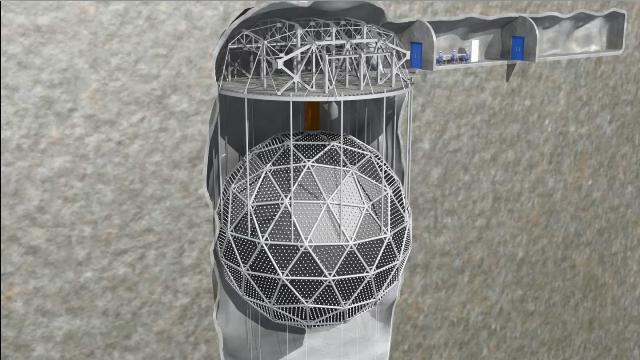Nov 11 2015
Hot on the tail of this year's Nobel prize in physics, another prize came to the Sudbury Neutrino Observatory Collaboration -- the 2016 Breakthrough Prize in Fundamental Physics. The honor went to researchers -- six of whom are now at the Department of Energy's Pacific Northwest National Laboratory -- "for the fundamental discovery of neutrino oscillations, revealing a new frontier beyond, and possibly far beyond, the standard model of particle physics."
 SNO is housed deep below the surface to shield the neutrino detector from cosmic rays. Credit: SNO Collaboration
SNO is housed deep below the surface to shield the neutrino detector from cosmic rays. Credit: SNO Collaboration
The lead researcher of the collaboration, Queen's University professor emeritus Arthur McDonald, represented the body of work in receiving the Nobel prize, but for this prize, all of the more than 270 researchers were honored.
The six PNNL researchers honored with the Breakthrough Prize continue to work on a variety of physics questions. They are Laboratory Fellows Andrew Hime and Dick Kouzes, along with researchers Brent VanDevender, John Orrell, Allan Myers, and Bryan Fulsom.
"PNNL is extremely proud of our staff on the SNO team and for the recognition of their work with the Breakthrough Prize," said Lou Terminello, who is the acting Associate Laboratory Director for the Physical and Computational Sciences Directorate. "This is a wonderful achievement for the physicists at PNNL who support several of DOE's core missions, including fundamental physics. We congratulate them and the entire SNO team."
Physicist Andrew Hime is the PNNL researcher most closely connected with SNO, a detector built in a deep underground mine in Canada. He started working on SNO at Los Alamos National Laboratory in 1991 and built up a vital SNO research group. Although SNO's detector stopped collecting data in 2006, researchers are still using the data to learn new things.
"SNO definitively showed that neutrinos born in the sun changed their identity en route to the earth, a discovery that, in concert with other experiments sharing the Breakthrough prize, implies that neutrinos have non-zero rest masses," Hime said.
That profound discovery -- that neutrinos change what type they are, which physicists call a neutrino's "flavor" -- came about because SNO's detector could see neutrinos in a couple different ways.
"We were working to resolve the solar neutrino puzzle," Hime said. "Physicists detected neutrinos that came from the sun, but fewer than expected based on how much the sun made. Either something funny was going on with neutrinos, or we didn't understand how the sun works."
Most neutrino detectors could only see one flavor, the electron-neutrino. SNO measured electron-neutrinos one way, and the sum total of neutrinos in a different way. Finding the missing neutrinos led them to realize that something funny was indeed going on with neutrinos.
"The smoking gun measurement from SNO demonstrated that one type of neutrino made in the sun changed in flavor. There was no other experiment that could do that," said Hime.
Other PNNL researchers who worked on SNO include three from the University of Washington -- Brent VanDevender, who did postdoctoral work there, John Orrell, who was working on his doctoral thesis, and Alan Myers. Bryan Fulsom worked on his master's degree in McDonald's group at Queen's University. Dick Kouzes also worked with Art when they were both professors at Princeton University, when SNO was just getting off the ground.
While the Nobel Prize honored key findings published from 2001 and 2002, the Breakthrough Foundation honored research through 2006. The award was presented at a ceremony at the NASA Ames Research Centre in Moffett Field, California. The ceremony, hosted by comedian Seth Macfarlane, was broadcast live in the U.S. on National Geographic Channel, with a one-hour version of the broadcast scheduled for Fox on Nov. 29, at 7 p.m.
Founded by Russian entrepreneur, venture capitalist and physicist Yuri Milner, The Breakthrough Prize in Fundamental Physics recognizes individuals who have made profound contributions to human knowledge. It is open to all physicists -- theoretical, mathematical and experimental -- working on the deepest mysteries of the Universe. The prize is one of three awarded by the Breakthrough Foundation for "Outstanding contributions in Life Sciences, Fundamental Physics, and Mathematics."